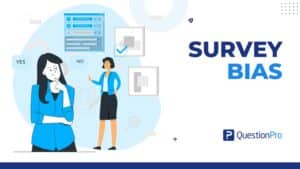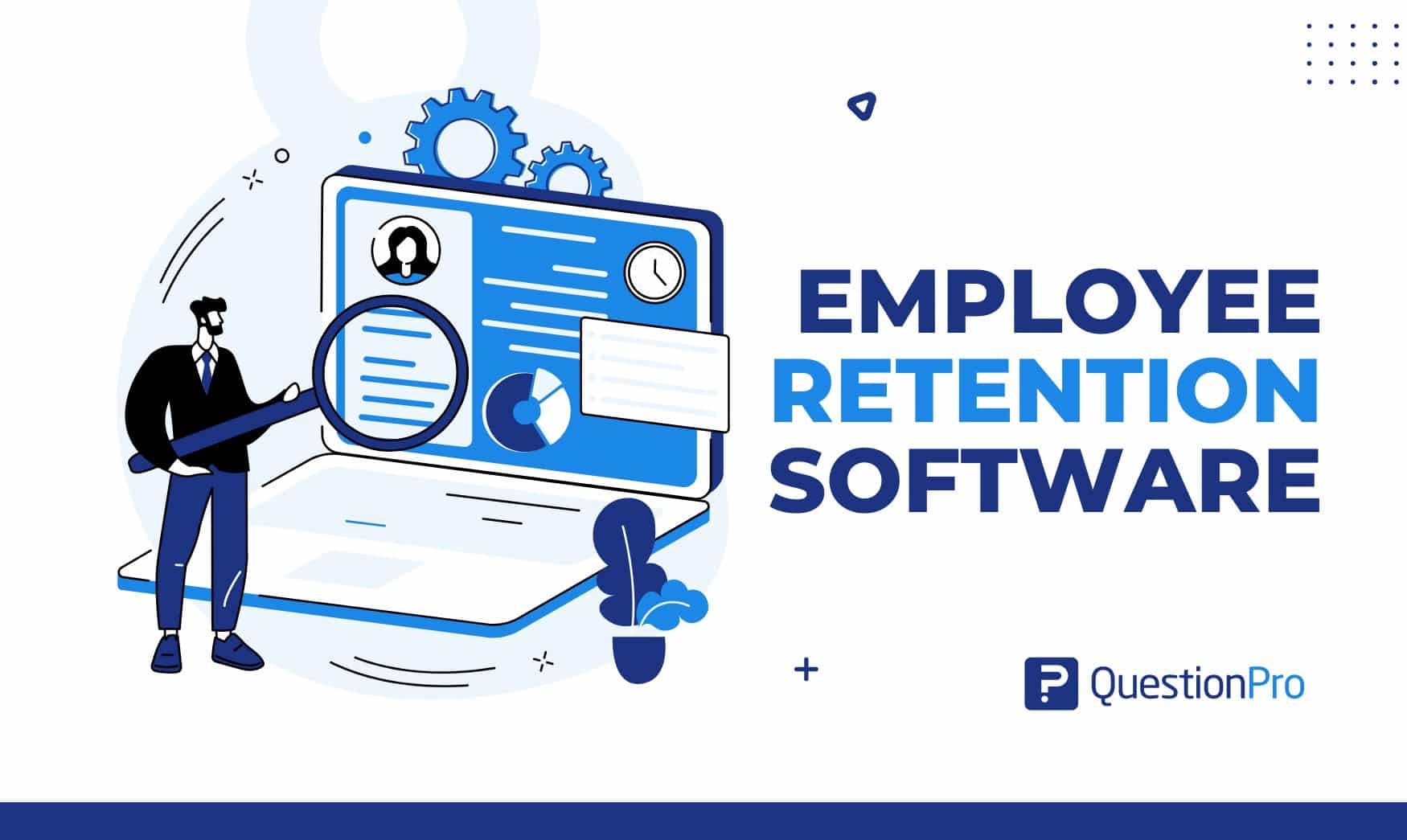
Employee retention is critical to any successful business. High turnover rates can harm productivity, morale, and the bottom line, but there’s hope. Companies are turning to employee retention software, a powerful tool that can help create a positive work environment and foster employee loyalty, leading to a more productive and harmonious workplace.
This blog will explore employee retention, strategies for creating effective retention programs, and the top 15 available software tools.
What is Employee Retention Software?
Employee retention refers to an organization’s ability to keep its employees engaged, satisfied, and motivated to continue working for the company over a prolonged period. It creates an environment where employees feel valued, supported, and challenged, reducing high employee turnover rates and fostering loyalty.
Employee retention software is a category of HR technology designed to help organizations monitor, analyze, and improve employee retention rates that helps to retain employees. These software solutions typically offer a range of features and tools to identify factors influencing employee turnover, measure employee satisfaction and engagement levels, and implement strategies to enhance retention.
15 Best Employee Retention Software
Employee retention software is essential for maintaining a happy and productive workforce. Here are 15 of the best options available:
1. QuestionPro
QuestionPro is a comprehensive survey software that enables organizations to gather employee feedback and insights to enhance engagement and retention.
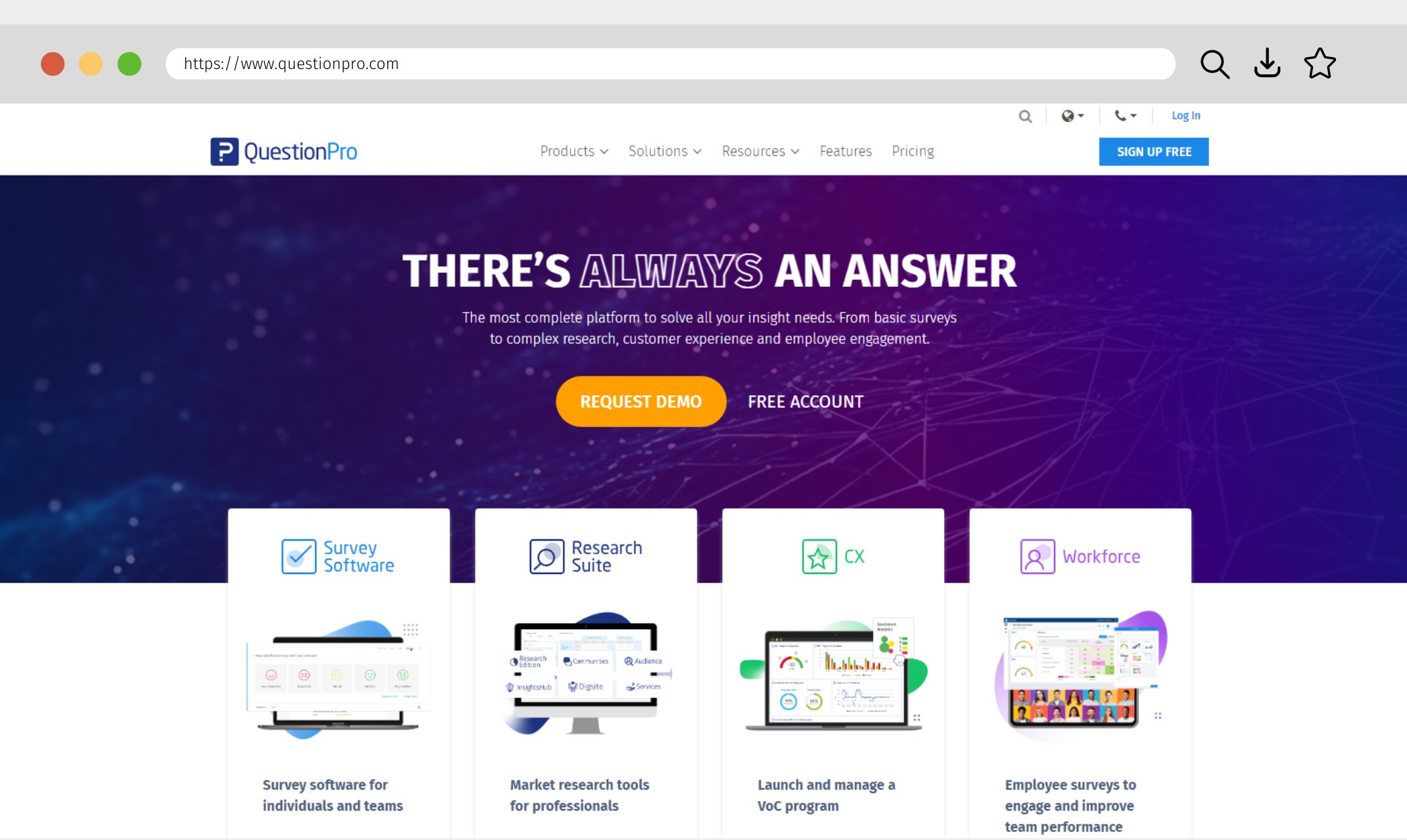
Features:
- Customizable surveys and questionnaires
- Real-time analytics and reporting
- Employee satisfaction tracking
- Pulse surveys for quick feedback
Pros:
- Easy-to-use interface
- Robust analytics for data-driven decision-making
- Flexible survey customization options
Price: Essentials is Free. Advanced is $99 per user/per month. Team Edition is $83 per user/per month. More customized pricing is available upon request.
2. SurveyMonkey
SurveyMonkey is a widely used survey platform that helps organizations collect and analyze employee feedback to improve retention strategies.
Features:
- Pre-designed survey templates
- Advanced survey logic and branching
- Collaboration tools for team feedback
- Integration with other software tools
Pros:
- Large user base and community support
- User-friendly interface
- Extensive customization options
Price: Team Advantage is $25/user/month, and Team Premier is $75/user/month. Contact Survey Monkey for more individual and customized pricing.
3. Bonusly
Bonusly is an employee recognition and rewards platform that boosts morale and motivation, leading to higher retention rates.
Features:
- Peer-to-peer recognition
- Customizable reward options
- Integration with HRIS and communication tools
- Analytics for tracking engagement
Pros:
- Encourages a positive work culture
- Transparent reward system
- Easy implementation and management
Price: Pro $5 per user/month, billed annually. Contact Bonusly for a more customized price.
4. Motivosity
Motivosity is an employee recognition and engagement platform that fosters a culture of appreciation and teamwork within organizations.
Features:
- Peer-to-peer recognition and feedback
- Social recognition feeds
- Performance tracking and analytics
- Integration with HR systems
Pros:
- Focuses on building strong relationships among employees
- Data-driven insights for improving retention strategies
- Mobile-friendly interface for accessibility
Price: $4 per user/month, billed annually. Contact Motivosity for a more customized price.
5. BambooHR
BambooHR is human resource management software offering various tools for employee onboarding, employee performance management, and retention.
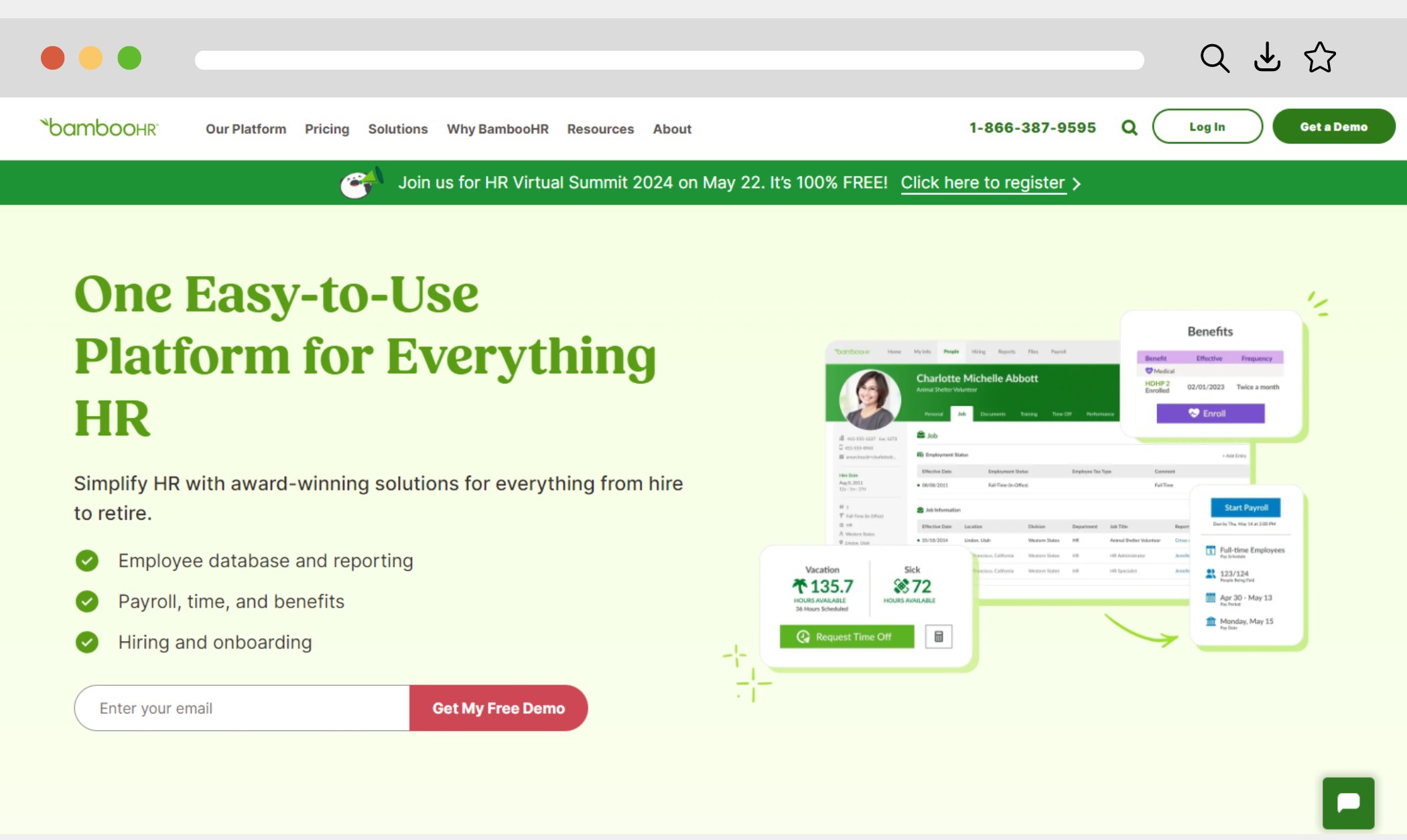
Features:
- Applicant tracking system
- Employee self-service portal
- Performance reviews and goal-setting
- Time-off tracking and scheduling
Pros:
- All-in-one HR solution
- Intuitive interface
- Scalable for businesses of all sizes
Price: Customized pricing is available upon request.
6. Zenefits
Zenefits is a cloud-based HR platform streamlining various HR processes, including onboarding, benefits administration, and compliance management.
Features:
- Automated onboarding workflows
- Benefits administration
- Time tracking and payroll
- Compliance tools
Pros:
- Simplifies HR tasks
- Integrates with popular business applications
- Provides compliance support
Price: Customized pricing is available upon request.
7. Zoho People
Zoho People is an HR management software offering employee onboarding, performance management, and attendance tracking features.
Features:
- Employee database and self-service portal
- Performance appraisal tools
- Time tracking and attendance management
- Customizable workflows
Pros:
- Affordable pricing
- User-friendly interface
- Comprehensive HR functionalities
Price: Price starts for ESSENTIAL HR US$1.25 /user/month billed annually
8. Microsoft Teams
Microsoft Teams is a collaboration platform that integrates chat, video conferencing, file sharing, and productivity tools to enhance communication and teamwork.
Features:
- Instant messaging and group chats
- Video conferencing and screen sharing
- Integration with Microsoft 365 apps
- File storage and collaboration
Pros:
- Seamless integration with other Microsoft tools
- Wide range of collaboration features
- Secure and compliant
Price: Customized pricing is available upon request.
9. Slack
Slack is a popular team messaging app that facilitates real-time communication and collaboration through channels, direct messages, and integrations.
Features:
- Channel-based communication
- File sharing and collaboration
- App integrations for automation
- Searchable message history
Pros:
- Easy to set up and use
- Extensive app directory for customization
- Improves team communication and productivity
Price: Price starts from Pro More power for small teams who want better collaboration $7.25 USD/mo*
10. Leapsome
Leapsome is an all-in-one platform for employee feedback, performance management, and learning and development, designed to foster a culture of continuous improvement.
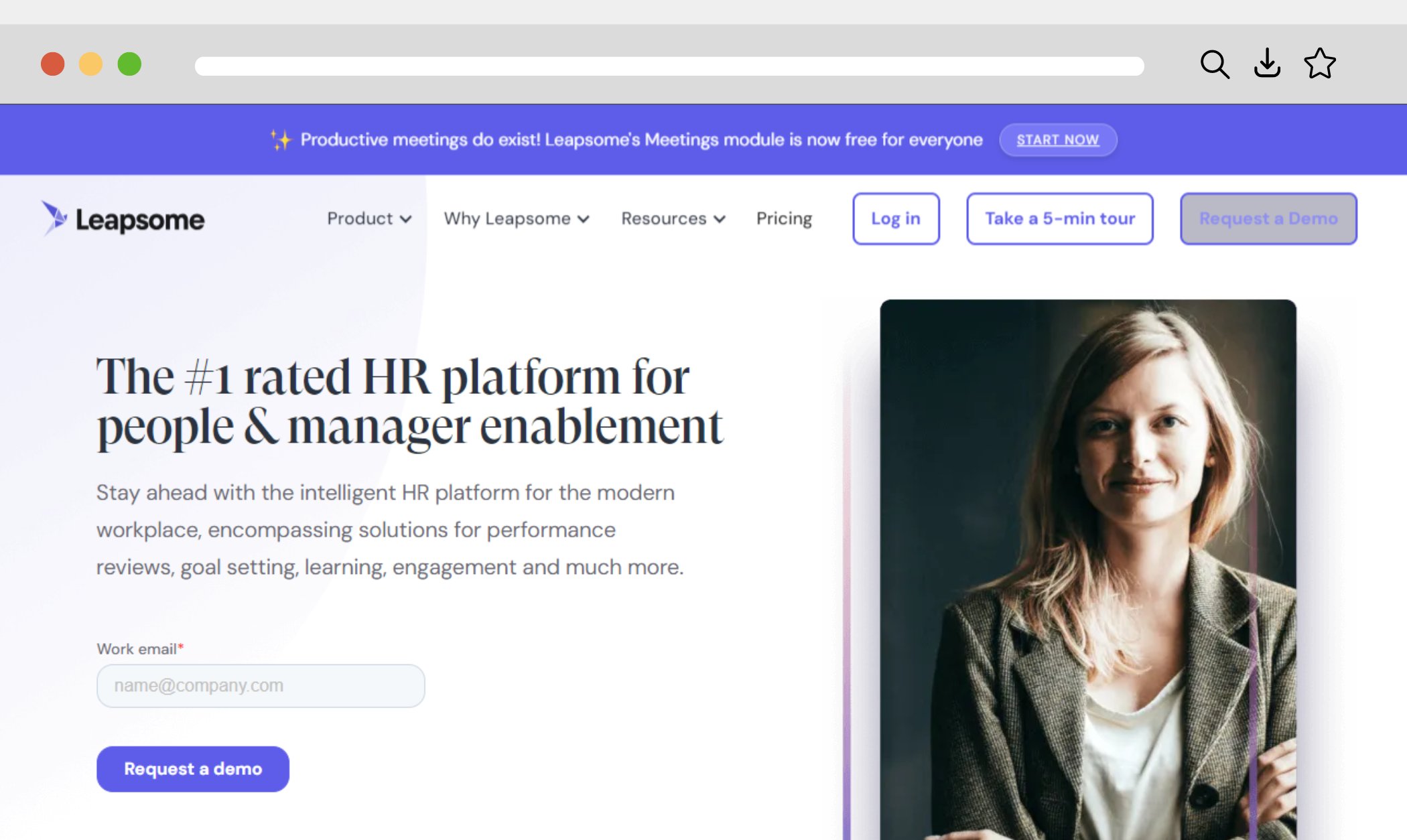
Features:
- 360-degree feedback and performance reviews
- Goal setting and tracking
- Employee engagement surveys
- Learning management system (LMS)
Pros:
- Comprehensive solution for talent management
- Personalized learning pathways
- Actionable insights for performance improvement
Price: Customized pricing is available upon request.
11. Deel
Deel is a global payroll and compliance platform that helps businesses manage international payments, contracts, and compliance for remote teams.
Features:
- Global payroll processing
- Contract management
- Compliance support for international hiring
- Secure payment processing
Pros:
- Simplifies international payroll and compliance
- Streamlines remote team management
- Ensures legal compliance in different countries
Price: Customized pricing is available upon request.
12. WorkTango
WorkTango is an employee engagement platform that provides pulse surveys, feedback collection, and action planning tools to improve employee satisfaction and retention.
Features:
- Real-time pulse surveys
- Anonymous feedback collection
- Action planning and follow-up
- Benchmarking against industry standards
Pros:
- Focuses on continuous feedback and improvement
- User-friendly interface for both employees and managers
- Provides actionable insights for HR professionals and teams
Price: Customized pricing is available upon request.
13. Cooleaf
Cooleaf is an employee engagement platform that offers rewards, recognition, and wellness programs to enhance employee satisfaction and retention.
Features:
- Employee recognition and rewards
- Wellness challenges and activities
- Social recognition feeds
- Analytics for tracking engagement
Pros:
- Promotes a healthy work-life balance
- Gamification elements for increased participation
- Customizable programs to fit the company culture
Price: Customized pricing is available upon request.
14. Mo
Mo is an employee engagement platform that leverages AI-driven insights to deliver personalized recommendations for improving employee motivation and retention.
Features:
- AI-powered engagement analytics
- Personalized coaching and recommendations
- Team sentiment analysis
- Integration with communication tools
Pros:
- Utilizes advanced AI technology for insights
- Focuses on individualized employee experiences
- Helps managers identify areas for improvement proactively
Price: Customized pricing is available upon request.
15. Nectar
Nectar is an employee recognition platform that allows organizations to create a culture of appreciation through peer-to-peer recognition, rewards, and celebrations.
Features:
- Peer-to-peer recognition and nominations
- Reward points and redemption options
- Celebration boards and social recognition
- Integration with HR systems
Pros:
- Encourages a culture of gratitude and appreciation
- Provides tangible rewards for employee recognition
- Integrates seamlessly with existing HR infrastructure
Price: Customized pricing is available upon request.
Are you thinking about improving your understanding of your customers? Dive into QuestionPro’s latest blog on their Customer Insight Platform!
How to Improve Employee Retention?
Improving employee retention involves creating a supportive work environment where employees feel valued, engaged, and motivated to stay with the company. Here are several strategies to enhance employee retention:
Competitive Compensation and Benefits
To attract and retain top talent, offer competitive salaries and benefits packages. Ensure that your compensation packages align with industry standards and include perks such as health insurance, retirement plans, and flexible work arrangements.
Career Development Opportunities
Provide opportunities for employees to advance their careers within the organization through training, mentorship programs, and skill development initiatives. Offer clear pathways for promotion and growth to encourage employees to stay and progress in their roles.
Work-Life Balance
Promote a healthy work-life balance by offering flexible work schedules, telecommuting options, and paid time off. Encourage employees to take breaks, prioritize self-care, and maintain boundaries between work and personal life to prevent burnout and improve overall well-being.
Positive Work Culture
Foster a positive work culture that values diversity, inclusion, and respect. Promote open communication, collaboration, and teamwork, and regularly recognize and celebrate employee achievements and contributions. Create a supportive and inclusive environment where employees feel valued, appreciated, and motivated to excel.
Recognition and Rewards
Implement recognition and rewards programs to acknowledge and reward employees for their hard work, dedication, and contributions to the organization’s success. Offer formal and informal recognition, such as employee of the month awards, peer-to-peer recognition, and bonuses or incentives for exceptional performance.
Employee Engagement
Engage employees in decision-making processes, solicit their input and feedback on company initiatives, and empower them to contribute ideas and suggestions for improvement. Provide socialization and team bonding opportunities through team-building activities, events, and volunteer opportunities.
Effective Leadership
Invest in leadership development programs to equip managers with the skills and tools to lead and support their teams effectively. Provide opportunities for managers to build strong relationships with their employees, offer coaching and mentorship, and provide regular feedback and recognition.
Regular Feedback and Communication
Establish open and transparent communication channels between employees and management to address concerns, provide feedback, and foster trust and transparency. Conduct regular check-ins, performance reviews, and employee surveys to gather feedback and identify areas for improvement.
Employee Well-being Programs
Implement wellness programs and initiatives to support employee health and well-being. Offer resources and support for managing stress, promoting mental health, and maintaining work-life balance, such as employee assistance programs, mindfulness workshops, and wellness challenges.
Exit Interviews and Feedback
Conduct exit interviews with departing employees to gather feedback about their reasons for leaving and experiences with the organization. Use this information to identify trends, address underlying issues, and improve the employee retention strategy.
How to Choose Employee Retention Software for Your Company
Choosing the right employee retention software tool is critical for managing and improving employee satisfaction, engagement, and retention. Consider these factors:
- Identify Your Needs: Define your objectives and requirements based on your organization’s size, industry, and retention challenges.
- Evaluate Features: Look for comprehensive features like surveys, performance management, recognition programs, analytics, and integration with HR systems.
- Integration Compatibility: Ensure seamless integration with existing HR systems and workflows for smooth implementation and data synchronization.
- Scalability: Choose software that can grow with your business and adapt to changing needs.
- Usability: Prioritize user-friendly software with intuitive interfaces for both administrators and employees.
- Vendor Reputation: Research the vendor’s reputation for delivering quality products and excellent customer support.
- Data Security: Verify compliance with industry regulations and robust security measures to protect sensitive employee information.
- Cost and ROI: Consider total ownership costs and evaluate the potential ROI regarding improved retention rates and productivity.
- Customer Support: Assess the level of support and training provided for implementation and ongoing usage.
- Seek Feedback: Solicit input from HR and IT professionals and seek references from the vendor’s existing customers.
Ways to Create Your Employee Retention Program
Creating an effective employee retention program requires a strategic approach that addresses the needs and concerns of employees while aligning with the company’s goals and values. Here are some key ways to develop a comprehensive employee retention program:
Identify Retention Goals and Objectives
- Define clear objectives for your retention program, such as reducing turnover rates, increasing employee engagement, or improving workplace satisfaction.
- Align these goals with the organization’s strategic objectives to ensure consistency and relevance.
Conduct Employee Feedback Surveys
- Gather employee feedback through surveys, interviews, or focus groups to understand their perceptions, needs, and areas for improvement.
- Use this feedback to identify factors influencing retention, such as job satisfaction, work-life balance, career development opportunities, and compensation.
Develop Competitive Compensation and Benefits Packages
- Offer competitive salaries and benefits packages to attract and retain top talent.
- Regularly review and benchmark compensation and benefits against industry standards to ensure competitiveness.
Provide Opportunities for Career Development
- We offer training programs, professional development opportunities, and career advancement pathways to support employee growth and progression within the organization.
- Encourage employees to pursue further education, certifications, or skill development relevant to their roles.
Promote Work-Life Balance
- Implement policies and practices that support work-life balance, such as flexible work arrangements, telecommuting options, and generous leave policies.
- Encourage managers to model and promote healthy work-life balance behaviors and discourage overwork or burnout.
Encourage a Positive Work Culture
- Cultivate a supportive and inclusive work environment where employees feel valued, respected, and appreciated.
- Promote open communication, collaboration, and teamwork among employees, management, and staff.
Recognize and Reward Employee Contributions
- Implement employee recognition programs to acknowledge and reward employees for their contributions, achievements, and milestones.
- Provide formal and informal recognition opportunities, such as awards, incentives, praise, and peer-to-peer recognition.
Offer Employee Wellness Programs
- Support employee well-being and health by offering wellness programs, initiatives, and resources.
- Provide access to mental health support, counseling services, fitness facilities, and healthy lifestyle programs.
Ensure Effective Leadership and Management
- Train and develop managers as influential leaders who inspire, motivate, and support their teams.
- Provide managers with the tools, resources, and guidance necessary to address employee concerns, provide constructive feedback, and resolve conflicts.
Measure and Monitor Retention Metrics
- Establish key performance indicators (KPIs) to measure the effectiveness of your retention program, such as turnover rates, employee engagement scores, and satisfaction surveys.
- Regularly monitor these metrics to track progress, identify trends, and make data-driven adjustments to your retention strategies.
How QuestionPro Workforce Can Help in Employee Retention
QuestionPro Workforce is a versatile survey tool that can significantly improve employee retention. Here’s how QuestionPro Workforce can help:
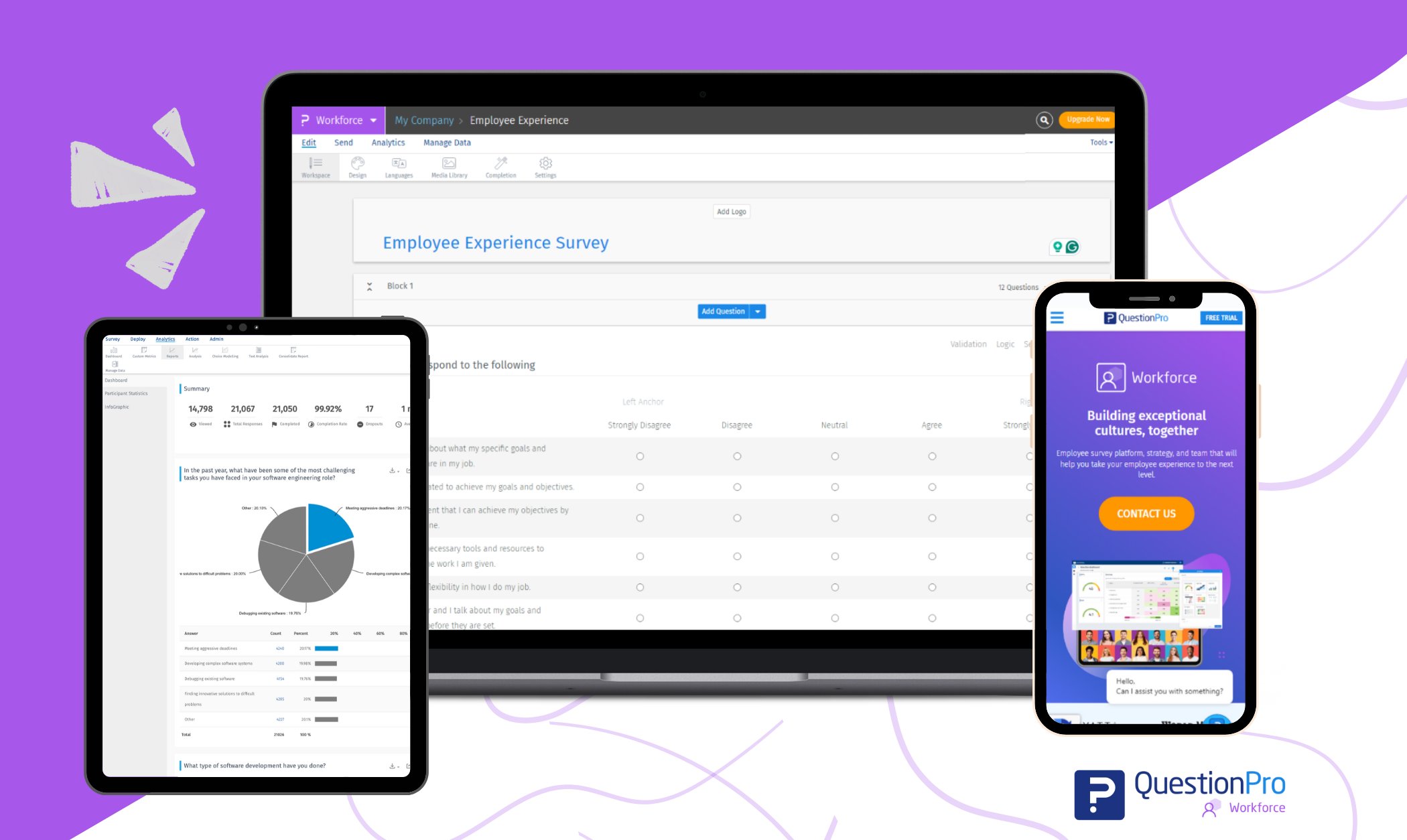
- Gather Employee Feedback: It allows companies to collect feedback on various aspects like job satisfaction, work-life balance, and career development through surveys, polls, and questionnaires. This insight helps identify factors affecting retention.
- Measure Employee Engagement: Offering tools for pulse surveys and satisfaction assessments enables tracking engagement levels over time, pinpointing areas for improvement to enhance retention.
- Identify Retention Risks: Advanced analytics helps identify potential turnover factors such as low morale or inadequate growth opportunities. This enables proactive intervention to mitigate risks.
- Implement Retention Strategies: With insights from feedback and engagement data, organizations can devise targeted retention strategies, set goals, and monitor progress, ensuring effective implementation.
- Enhance Communication and Transparency: It fosters communication between employees and management, providing a platform for sharing results, seeking feedback, and conveying organizational changes, fostering trust and reducing turnover.
- Demonstrate Commitment to Employee Feedback: Utilizing QuestionPro Workforce to gather and act on feedback showcases a commitment to valuing employees’ opinions, which boosts morale, loyalty, and, ultimately, retention rates.
Conclusion
Employee retention data is critical to building a successful and sustainable business. Companies can create a work environment where employees feel valued, engaged, and motivated to contribute to the organization’s success by investing in employee retention software tools and implementing effective retention strategies.
With the right employee retention tools and initiatives, they can reduce turnover rates, improve employee satisfaction, and ultimately achieve their business goals.
QuestionPro Workforce provides a comprehensive set of tools and features to help organizations improve employee retention rates by fostering a positive work environment, enhancing employee engagement, and addressing key drivers of turnover.
By leveraging the platform’s capabilities, organizations can create a workplace where employees feel valued, supported, and motivated to stay and contribute to the organization’s success.




